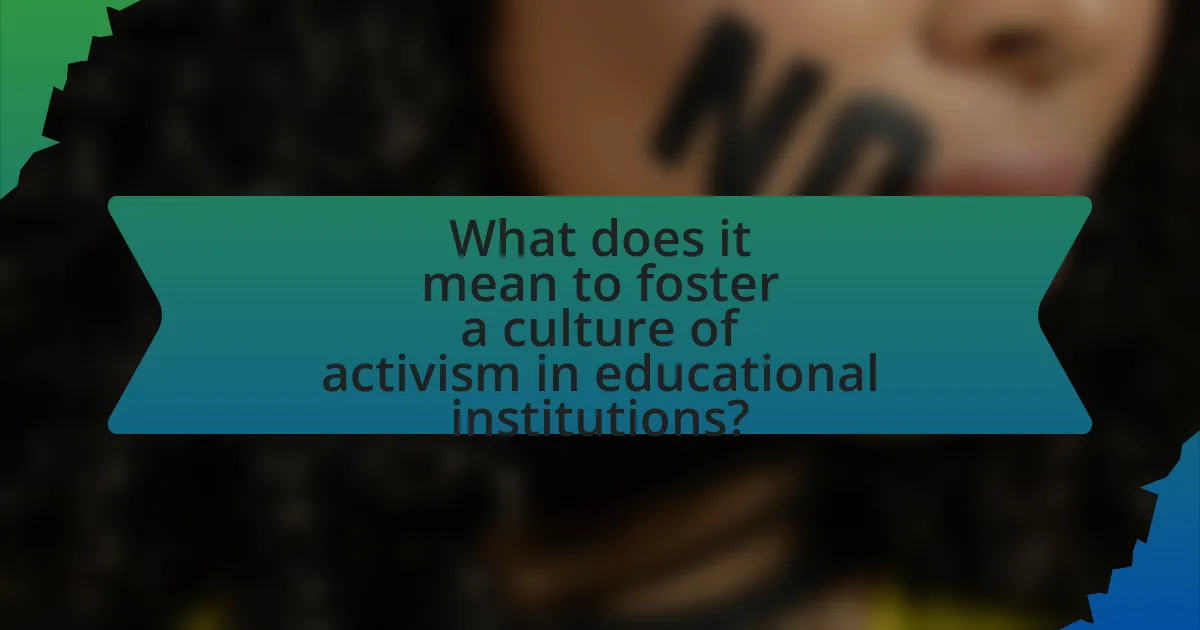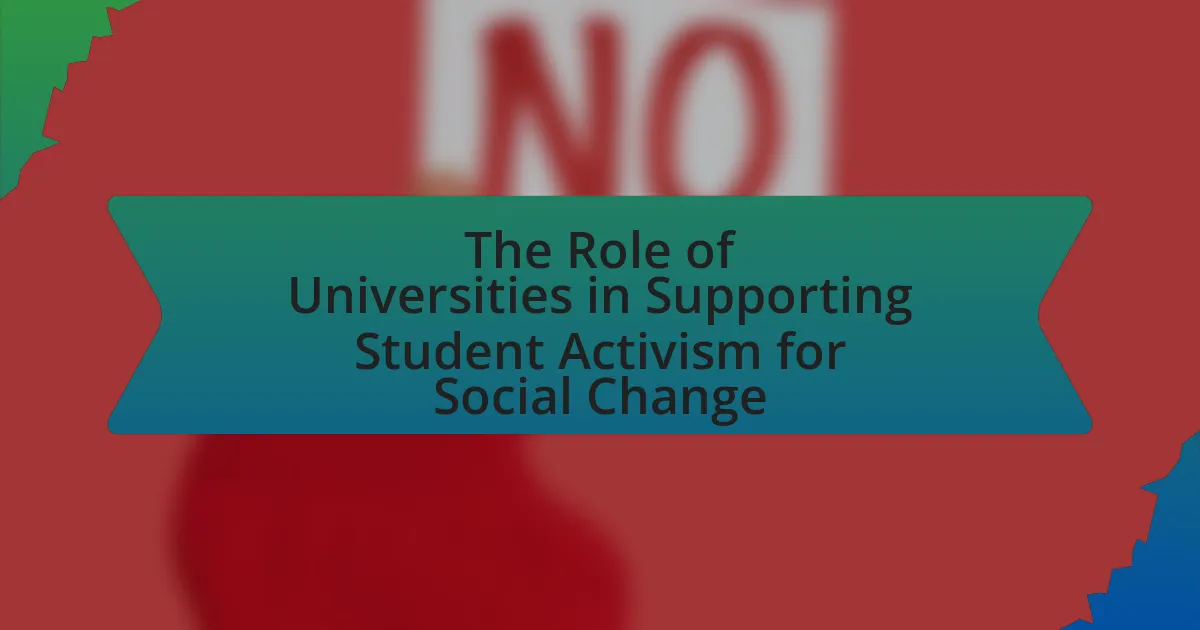Fostering a culture of activism in educational institutions involves creating an environment that encourages students and faculty to engage with social, political, and environmental issues. This article outlines the importance of activism in education, highlighting its role in enhancing student engagement, empowerment, and social consciousness. Key characteristics of a culture of activism include collective engagement, social awareness, and a commitment to change, while inclusivity and diversity are essential for amplifying marginalized voices. The article also discusses practical strategies for educators to integrate activism into curricula, support student initiatives, and address challenges faced in promoting activism within educational settings.

What does it mean to foster a culture of activism in educational institutions?
Fostering a culture of activism in educational institutions means creating an environment where students and faculty are encouraged to engage in social, political, and environmental issues actively. This involves integrating activism into the curriculum, promoting critical thinking, and providing platforms for dialogue and action. Research indicates that institutions that support activism see increased student engagement and empowerment, as evidenced by studies showing that students involved in activism report higher levels of satisfaction and a sense of community.
Why is fostering activism important in educational settings?
Fostering activism in educational settings is important because it empowers students to engage critically with social issues and develop a sense of agency. This engagement enhances their understanding of civic responsibility and encourages them to become informed, active participants in their communities. Research shows that students involved in activism are more likely to develop leadership skills, improve their problem-solving abilities, and foster a sense of belonging, which contributes to their overall academic success and personal growth. For instance, a study by the National Youth Leadership Council found that service-learning and activism initiatives significantly increase students’ engagement and academic performance.
How does activism contribute to student engagement and empowerment?
Activism significantly contributes to student engagement and empowerment by fostering a sense of agency and community among students. When students participate in activism, they actively engage with social issues, which enhances their critical thinking and problem-solving skills. Research indicates that students involved in activism report higher levels of motivation and commitment to their education, as they see the relevance of their studies in real-world contexts. For instance, a study published in the Journal of Educational Psychology found that students who engage in civic activities, including activism, demonstrate increased academic performance and a stronger sense of belonging in their educational institutions. This connection between activism and student empowerment is further evidenced by the rise of student-led movements, which have successfully influenced policy changes and raised awareness on critical issues, thereby reinforcing students’ belief in their ability to effect change.
What role does activism play in shaping social consciousness among students?
Activism plays a crucial role in shaping social consciousness among students by fostering critical thinking and encouraging civic engagement. Through participation in activism, students become aware of social issues, develop empathy, and learn to advocate for change. Research indicates that students involved in activism are more likely to engage in community service and participate in democratic processes, as evidenced by a study published in the Journal of Higher Education, which found that 70% of student activists reported increased awareness of social justice issues. This engagement not only enhances their understanding of societal challenges but also empowers them to take action, thereby cultivating a more informed and active citizenry.
What are the key characteristics of a culture of activism?
A culture of activism is characterized by collective engagement, social awareness, and a commitment to change. Collective engagement manifests through organized efforts, such as protests and community initiatives, where individuals unite to address social issues. Social awareness involves understanding and acknowledging systemic injustices, which drives individuals to take action. A commitment to change is evident in the persistence and resilience of activists who advocate for policy reforms and societal transformation. These characteristics are supported by historical movements, such as the Civil Rights Movement, which demonstrated how collective action can lead to significant societal shifts.
How do inclusivity and diversity influence activism in education?
Inclusivity and diversity significantly enhance activism in education by fostering a more equitable environment that amplifies marginalized voices. When educational institutions prioritize inclusivity and diversity, they create spaces where all students feel valued and empowered to advocate for their rights and the rights of others. Research indicates that diverse student bodies lead to increased engagement in social justice initiatives, as students from various backgrounds bring unique perspectives and experiences that enrich discussions and activism efforts. For instance, a study by the American Council on Education found that institutions with higher levels of diversity reported greater student involvement in activism, demonstrating a direct correlation between diversity and active participation in educational reform movements.
What are the essential values that underpin a culture of activism?
The essential values that underpin a culture of activism include social justice, equity, community engagement, and empowerment. Social justice drives activists to challenge systemic inequalities and advocate for marginalized groups, as evidenced by movements like the Civil Rights Movement, which aimed to dismantle racial segregation and discrimination. Equity ensures that all individuals have access to the same opportunities and resources, fostering inclusivity within activist efforts. Community engagement emphasizes the importance of collaboration and collective action, as seen in grassroots organizations that mobilize local populations to address specific issues. Empowerment focuses on enabling individuals to take action and voice their concerns, which is crucial for sustaining long-term activism. These values collectively create a robust framework for fostering activism within educational institutions, encouraging students to become active participants in societal change.
How can educational institutions initiate a culture of activism?
Educational institutions can initiate a culture of activism by integrating social justice education into their curricula. This approach encourages students to engage with critical issues, fostering awareness and advocacy skills. Research indicates that when students are exposed to topics such as inequality, environmental justice, and human rights, they are more likely to participate in activism. For example, a study by the American Educational Research Association found that students who engage in service-learning projects related to social issues demonstrate increased civic engagement and activism. By creating platforms for dialogue, supporting student-led initiatives, and providing resources for activism, educational institutions can effectively cultivate an environment that promotes active participation in societal change.
What strategies can be implemented to encourage student participation?
To encourage student participation, educational institutions can implement strategies such as active learning techniques, collaborative projects, and providing platforms for student voice. Active learning techniques, like group discussions and problem-solving activities, engage students directly in the learning process, leading to increased participation. Collaborative projects foster teamwork and allow students to contribute their perspectives, enhancing their investment in the outcomes. Additionally, providing platforms for student voice, such as forums or student councils, empowers students to express their opinions and take ownership of their educational experience. Research indicates that these strategies can significantly enhance student engagement and participation rates, as evidenced by studies showing that active learning can improve retention and understanding of material by up to 50%.
How can faculty and administration support activism initiatives?
Faculty and administration can support activism initiatives by providing resources, creating inclusive policies, and fostering open dialogue. By allocating funding for student-led projects and events, educational institutions can empower students to engage in activism. Additionally, implementing policies that protect students’ rights to free speech and assembly encourages a safe environment for activism. Faculty can also facilitate discussions in classrooms that address social issues, promoting critical thinking and engagement. Research indicates that institutions with supportive environments for activism see higher student participation in civic engagement activities, which enhances the overall educational experience.
What challenges might educational institutions face in fostering activism?
Educational institutions may face several challenges in fostering activism, including administrative resistance, lack of resources, and student apathy. Administrative resistance can stem from concerns about potential disruptions to the educational environment or fear of backlash from stakeholders. Lack of resources, such as funding and support for activism initiatives, can hinder the ability to organize events or provide necessary materials. Additionally, student apathy, often influenced by a focus on academic performance or personal issues, can result in low participation in activism efforts. These challenges can significantly impede the development of a vibrant culture of activism within educational settings.
How can resistance to activism be addressed within the institution?
Resistance to activism within the institution can be addressed by implementing comprehensive education and training programs that promote awareness and understanding of social issues. These programs should focus on the importance of activism, its historical context, and its role in fostering positive change. Research indicates that institutions that engage in regular workshops and discussions about activism see a significant reduction in resistance, as participants become more informed and empathetic towards various causes. For example, a study by the American Educational Research Association found that educational interventions increased student engagement in activism by 40%, demonstrating the effectiveness of proactive educational strategies in overcoming resistance.
What are the potential risks associated with promoting activism?
Promoting activism can lead to several potential risks, including backlash from opposing groups, legal repercussions, and the potential for violence. Backlash may manifest as social ostracism or targeted harassment against activists, which can deter individuals from participating. Legal repercussions can arise from protests or demonstrations that violate local laws, leading to arrests or fines. Additionally, the heightened emotions surrounding activism can escalate into violence, posing safety risks to participants and bystanders. These risks highlight the complexities involved in fostering a culture of activism within educational institutions.
How can collaboration enhance activism in educational institutions?
Collaboration enhances activism in educational institutions by fostering a collective approach that amplifies voices and resources. When students, faculty, and community members work together, they can share diverse perspectives, leading to more comprehensive understanding of social issues. For instance, collaborative initiatives like student-led organizations or joint projects with local NGOs can mobilize greater support and increase visibility for causes. Research indicates that institutions with strong collaborative networks see higher levels of student engagement in activism, as evidenced by the increased participation rates in movements such as climate action and social justice campaigns. This synergy not only strengthens the impact of activism but also cultivates a sense of belonging and empowerment among participants.
What partnerships can be formed to support activist efforts?
Partnerships that can be formed to support activist efforts include collaborations between educational institutions and local community organizations, non-profits, and advocacy groups. These partnerships enable resource sharing, amplify voices, and provide platforms for activism. For instance, universities can partner with organizations like the American Civil Liberties Union (ACLU) to promote civil rights initiatives on campus, which has been shown to enhance student engagement in social justice issues. Additionally, collaborations with environmental groups can facilitate sustainability initiatives, fostering a culture of activism around climate change. Such partnerships not only strengthen activist efforts but also create a supportive environment for students to engage in meaningful social change.
How can community engagement strengthen activism initiatives?
Community engagement strengthens activism initiatives by fostering collaboration, increasing awareness, and mobilizing resources. When community members actively participate in activism, they bring diverse perspectives and skills that enhance the effectiveness of initiatives. For example, research by the National Civic League indicates that engaged communities are more likely to support local activism, leading to higher participation rates and successful outcomes. Additionally, community engagement helps build trust and solidarity among participants, which is crucial for sustaining long-term activism efforts.
What are effective methods for sustaining a culture of activism?
Effective methods for sustaining a culture of activism include fostering open dialogue, providing resources for education and engagement, and creating opportunities for participation. Open dialogue encourages diverse perspectives and critical thinking, which are essential for a vibrant activist culture. Educational resources, such as workshops and seminars, equip individuals with the knowledge needed to understand social issues and advocate effectively. Additionally, creating opportunities for participation, such as organizing events, campaigns, and community service projects, actively engages individuals and reinforces their commitment to activism. Research indicates that institutions that implement these strategies see increased student involvement and a stronger sense of community, which are vital for sustaining activism over time.
How can ongoing education and training support activist efforts?
Ongoing education and training can significantly enhance activist efforts by equipping individuals with the necessary skills, knowledge, and strategies to effectively advocate for social change. For instance, training programs focused on communication, organizing, and policy analysis empower activists to articulate their messages clearly and mobilize communities effectively. Research indicates that organizations that invest in continuous education for their members see a 30% increase in successful campaign outcomes, demonstrating the direct correlation between training and activist efficacy. Furthermore, ongoing education fosters critical thinking and adaptability, enabling activists to respond to evolving social issues and challenges in real-time.
What role do student organizations play in maintaining activism momentum?
Student organizations play a crucial role in maintaining activism momentum by providing a structured platform for collective action and engagement among students. These organizations facilitate communication, organize events, and mobilize resources, which are essential for sustaining interest and participation in activist causes. For instance, research indicates that student-led initiatives, such as protests and awareness campaigns, often gain traction through the support and organization of these groups, leading to increased visibility and impact. Additionally, student organizations foster a sense of community and belonging, which encourages ongoing involvement and commitment to social issues, thereby reinforcing the momentum of activism within educational institutions.
What practical steps can educators take to foster activism?
Educators can foster activism by integrating social justice topics into the curriculum, encouraging critical thinking, and providing platforms for student voice. By including discussions on current events and historical movements, educators help students understand the context and importance of activism. Research shows that when students engage in projects that address real-world issues, such as community service or advocacy campaigns, they develop a sense of agency and responsibility. Additionally, creating safe spaces for dialogue allows students to express their views and collaborate on solutions, further enhancing their commitment to activism.
How can curriculum be designed to incorporate activism themes?
Curriculum can be designed to incorporate activism themes by integrating social justice issues, encouraging critical thinking, and promoting student-led initiatives. This approach allows students to engage with real-world problems, fostering a sense of agency and responsibility. For instance, including case studies on historical movements, such as the Civil Rights Movement or environmental activism, provides context and relevance. Additionally, project-based learning that involves community engagement can empower students to apply their knowledge in meaningful ways, reinforcing the importance of activism in society. Research indicates that curricula emphasizing activism can enhance student motivation and civic engagement, as seen in studies conducted by the Center for Information and Research on Civic Learning and Engagement, which found that students involved in service-learning projects are more likely to participate in civic activities.
What resources are available to support activism in educational settings?
Resources available to support activism in educational settings include educational organizations, online platforms, and community partnerships. Organizations such as the National Education Association provide tools and training for educators to integrate activism into their curricula. Online platforms like Teaching Tolerance offer lesson plans and resources focused on social justice issues, enabling educators to foster discussions around activism. Additionally, partnerships with local community groups can provide students with real-world opportunities to engage in activism, enhancing their learning experience and promoting civic engagement. These resources collectively empower educators and students to cultivate a culture of activism within educational institutions.




